Advancing Structural Reinforcement in 3D-Printed Concrete: Current Methods, Challenges, and Innovations
Abstract
1. Introduction
2. Material Properties of 3D-Printed Concrete
2.1. Flowability
2.2. Extrudability
2.3. Buildability
3. Steel Reinforced 3D Printed Concrete
3.1. Manual Reinforcement
3.2. Automated Reinforcement
4. Fiber and Nanomaterial-Reinforced 3DPC
4.1. Types of Fibers and Their Applications in 3DPC
4.2. Applications of Nanomaterials in 3DPC
5. Methods to Improve Interlayer Adhesion in 3DPC
6. Discussion and Future Research Directions
7. Conclusions
- The 3DPC reinforcement method that forms a “reinforced cage-like” structure differs from traditional casting methods. During the printing process, the use of wire mesh reinforcement requires consideration of its effect on the interlayer bonding behavior of the concrete. Currently, research primarily focuses on the bond between concrete layers, with limited attention given to the influence of wire mesh. Further exploration in this area could provide valuable insights.
- Research on the synergistic effects of reinforcement methods, such as wire mesh, fiber materials, and nanomaterials, remains underdeveloped. The future of 3D-printed concrete construction should prioritize the interaction between different reinforcement materials. By conducting in-depth research on wire mesh, fiber materials, and nanomaterials, more effective combinations can be identified to guide practical engineering applications.
- Section 6 introduces a method that effectively combines the advantages of both approaches, while reducing the number of horizontally placed steel meshes, thereby minimizing the weak layers between structural layers. Future research will further investigate the feasibility of the bidirectional steel mesh placement method.
Author Contributions
Funding
Institutional Review Board Statement
Informed Consent Statement
Data Availability Statement
Conflicts of Interest
Abbreviations
| 3DPC | 3D-Printed Concrete |
| 3DCP | 3D Concrete Printing |
| BIM | Building Information Modeling |
| PVAF | Polyvinyl alcohol fibers |
| PPF | Polypropylene fibers |
| SSF | Sisal fibers |
| GF | Glass fibers |
| CF | Carbon fiber |
| BF | Basalt fiber |
| SF | Steel fibers |
| CNTs | Carbon nanotubes |
| MWCNTs | Multi-walled carbon nanotubes |
| HNTs | Halloysite nanotubes |
| IS | Interlocking structure |
| SAPs | Superabsorbent polymers |
| Nc | Nanoclay |
| TS | Their self-synthesized slow-setting carboxylate superplasticizer |
| AG | Attapulgite |
| CSA | Calcium sulfoaluminate |
References
- Xia, K.; Chen, Y.; Liu, C.; Zhang, Y.; Jia, L.; Yu, Q.; Yang, M.; Jia, Z.; Pan, J.; Chen, C. Research progress on low carbon characters of 3D concrete printing based construction. J. Build. Struct. 2024, 45, 15–33. [Google Scholar] [CrossRef]
- Mechtcherine, V.; Nerella, V.N.; Will, F.; Näther, M.; Otto, J.; Krause, M. Large-scale digital concrete construction—CONPrint3D concept for on-site, monolithic 3D-printing. Autom. Constr. 2019, 107, 102933. [Google Scholar] [CrossRef]
- Dong, Y.H.; Jaillon, L.; Chu, P.; Poon, C. Comparing carbon emissions of precast and cast-in-situ construction methods—A case study of high-rise private building. Constr. Build. Mater. 2015, 99, 39–53. [Google Scholar] [CrossRef]
- Delgado Camacho, D.; Clayton, P.; O’Brien, W.J.; Seepersad, C.; Juenger, M.; Ferron, R.; Salamone, S. Applications of additive manufacturing in the construction industry—A forward-looking review. Autom. Constr. 2018, 89, 110–119. [Google Scholar] [CrossRef]
- Hong, J.; Shen, G.Q.; Feng, Y.; Lau, W.S.-t.; Mao, C. Greenhouse gas emissions during the construction phase of a building: A case study in China. J. Clean. Prod. 2015, 103, 249–259. [Google Scholar] [CrossRef]
- Meng, Q.; Hu, L.; Li, M.; Wan, D.; Wu, H.; Qi, X. Analysis of carbon emissions and carbon reduction rffect of 3D printing buildings based on LCA method. J. Saf. Environ. 2023, 23, 2523–2533. [Google Scholar] [CrossRef]
- Habibi, A.; Buswell, R.; Osmani, M.; Aziminezhad, M. Sustainability principles in 3D concrete printing: Analysing trends, classifying strategies, and future directions. J. Build. Eng. 2024, 98, 111354. [Google Scholar] [CrossRef]
- Nan, B.; Wang, L.; Liang, J.; Chi, Y.; Liu, W. Research on Structural Topology Optimization Based on Improved BESO Method. J. Shenyang Agric. Univ. 2024, 55, 583–593. [Google Scholar]
- Zhou, W.; Zhu, H.; Hu, W.H.; Wollaston, R.; Li, V.C. Low-carbon, expansive engineered cementitious composites (ECC) in the context of 3D printing. Cem. Concr. Compos. 2024, 148, 105473. [Google Scholar] [CrossRef]
- Zhang, D.; Feng, P.; Zhou, P.; Xu, W.; Ma, G. 3D printed concrete walls reinforced with flexible FRP textile: Automatic construction, digital rebuilding, and seismic performance. Eng. Struct. 2023, 291, 116488. [Google Scholar] [CrossRef]
- Van Tittelboom, K.; Mohan, M.K.; Šavija, B.; Keita, E.; Ma, G.; Du, H.; Kruger, J.; Caneda-Martinez, L.; Wang, L.; Bekaert, M.; et al. On the micro- and meso-structure and durability of 3D printed concrete elements. Cem. Concr. Res. 2024, 185, 107649. [Google Scholar] [CrossRef]
- Zhang, C.; Deng, Z.; Ma, L.; Liu, C.; Chen, Y.; Wang, Z.; Jia, Z.; Wang, X.; Jia, L.; Chen, C.; et al. Research Progress and Application of 3D Printing Concrete. Bull. Chin. Ceram. Soc. 2021, 40, 1769–1795. [Google Scholar] [CrossRef]
- Dilawar Riaz, R.; Usman, M.; Ali, A.; Majid, U.; Faizan, M.; Jalil Malik, U. Inclusive characterization of 3D printed concrete (3DPC) in additive manufacturing: A detailed review. Constr. Build. Mater. 2023, 394, 132229. [Google Scholar] [CrossRef]
- Bazli, M.; Ashrafi, H.; Rajabipour, A.; Kutay, C. 3D printing for remote housing: Benefits and challenges. Autom. Constr. 2023, 148, 104772. [Google Scholar] [CrossRef]
- Batikha, M.; Jotangia, R.; Baaj, M.Y.; Mousleh, I. 3D concrete printing for sustainable and economical construction: A comparative study. Autom. Constr. 2022, 134, 104087. [Google Scholar] [CrossRef]
- Mao, Y.; Guo, Z.; Chen, H.; Zhang, J.; Luo, J.; Liu, C.; Shang, H. Study Progress on Reinforcement Technology for 3D Printing Concrete. Bull. Chin. Ceram. Soc. 2024, 43, 1557–1568. [Google Scholar] [CrossRef]
- Xiao, J.; Lyu, Z.; Liu, H. A Fundamental Study Progress on Reinforcement Enhancement of 3D Printed Concrete. Bull. Chin. Ceram. Soc. 2024, 43, 1545–1556. [Google Scholar] [CrossRef]
- Tang, J.; Xi, Y.; Gao, D.; Yang, L.; You, P.; Fang, D. Review on Printability of 3D Printed Concrete. China Concr. Cem. Prod. 2022, 66, 18–23. [Google Scholar] [CrossRef]
- Butkutė, K.; Vaitkevičius, V.; Adomaitytė, F. Eco-Friendly 3D-Printed Concrete Made with Waste and Organic Artificial Aggregates. Materials 2024, 17, 3290. [Google Scholar] [CrossRef]
- Zeng, X.; Wang, L. Research on the Design of 3D Printing Mix Proportion Test of Solid Waste Recycled Concrete. Eng. Technol. Res. 2023, 8, 105–107. [Google Scholar] [CrossRef]
- Ma, L.; Jia, Z.; Chen, Y.; Jiang, Y.; Huet, B.; Delaplace, A.; Zhang, Y.; Zhang, Q. Water loss and shrinkage prediction in 3D printed concrete with varying w/c and specimen sizes. Cem. Concr. Compos. 2024, 149, 105523. [Google Scholar] [CrossRef]
- Wang, Y. Experimental study on freeze-thaw resistance of 3D printed hydraulic concrete. Water Conserv. Constr. Manag. 2023, 43, 20–23. [Google Scholar] [CrossRef]
- Zou, M.; Liu, C.; Zhang, K.; Li, W.; Cao, Q.; Zhang, L.; Gu, T.; Zhang, G.; Liu, L. Evaluation and control of printability and rheological properties of 3D-printed rubberized concrete. J. Build. Eng. 2023, 80, 107988. [Google Scholar] [CrossRef]
- Nodehi, M.; Aguayo, F.; Nodehi, S.E.; Gholampour, A.; Ozbakkaloglu, T.; Gencel, O. Durability properties of 3D printed concrete (3DPC). Autom. Constr. 2022, 142, 104479. [Google Scholar] [CrossRef]
- Paul, S.; van Zijl, G.; Tan, M.; Gibson, I. A review of 3D concrete printing systems and materials properties: Current status and future research prospects. Rapid Prototyp. J. 2018, 24, 784–798. [Google Scholar] [CrossRef]
- Zhang, C.; Deng, Z.; Chen, C.; Zhang, Y.; Mechtcherine, V.; Sun, Z. Predicting the static yield stress of 3D printable concrete based on flowability of paste and thickness of excess paste layer. Cem. Concr. Compos. 2022, 129, 104494. [Google Scholar] [CrossRef]
- Liu, Y.; Wang, L.; Yuan, Q.; Peng, J. Effect of coarse aggregate on printability and mechanical properties of 3D printed concrete. Constr. Build. Mater. 2023, 405, 133338. [Google Scholar] [CrossRef]
- Zhang, Y.; Chen, Y.; Liu, C. Printability, Mechanics, Shrinkage and Carbon Emission Analysis of 3D Printed Concrete with Coarse Aggregates. J. Chin. Ceram. Soc. 2023, 51, 2153–2165. [Google Scholar] [CrossRef]
- Pasupathy, K.; Ramakrishnan, S.; Sanjayan, J. 3D concrete printing of eco-friendly geopolymer containing brick waste. Cem. Concr. Compos. 2023, 138, 104943. [Google Scholar] [CrossRef]
- Le, T.T.; Austin, S.A.; Lim, S.; Buswell, R.A.; Gibb, A.G.F.; Thorpe, T. Mix design and fresh properties for high-performance printing concrete. Mater. Struct. 2012, 45, 1221–1232. [Google Scholar] [CrossRef]
- Tarhan, Y.; Şahin, R. Fresh and Rheological Performances of Air-Entrained 3D Printable Mortars. Materials 2021, 14, 2409. [Google Scholar] [CrossRef] [PubMed]
- Kondepudi, K.; Subramaniam, K.V. Formulation of alkali-activated fly ash-slag binders for 3D concrete printing. Cem. Concr. Compos. 2021, 119, 103983. [Google Scholar] [CrossRef]
- Shakor, P.; Nejadi, S.; Sutjipto, S.; Paul, G.; Gowripalan, N. Effects of deposition velocity in the presence/absence of E6-glass fibre on extrusion-based 3D printed mortar. Addit. Manuf. 2020, 32, 101069. [Google Scholar] [CrossRef]
- Ma, G.; Li, Z.; Wang, L. Printable properties of cementitious material containing copper tailings for extrusion based 3D printing. Constr. Build. Mater. 2018, 162, 613–627. [Google Scholar] [CrossRef]
- Ma, G.; Wang, L. A critical review of preparation design and workability measurement of concrete material for largescale 3D printing. Front. Struct. Civ. Eng. 2017, 12. [Google Scholar] [CrossRef]
- Wang, T.; Wang, S.; Chen, X.; Cui, W.; Wang, M. Studyontherheologicalpropertyandprintabilityof 3D printed concrete with low cement content. J. Qingdao Univ. Technol. 2024, 45, 52–58. [Google Scholar]
- Rehman, A.U.; Kim, J.H. 3D Concrete Printing: A Systematic Review of Rheology, Mix Designs, Mechanical, Microstructural, and Durability Characteristics. Materials 2021, 14, 3800. [Google Scholar] [CrossRef]
- Li, Z.; Hojati, M.; Wu, Z.; Piasente, J.; Ashrafi, N.; Duarte, J.P.; Nazarian, S.; Bilén, S.G.; Memari, A.M.; Radlińska, A. Fresh and Hardened Properties of Extrusion-Based 3D-Printed Cementitious Materials: A Review. Sustainability 2020, 12, 5628. [Google Scholar] [CrossRef]
- Ler, K.H.; Ma, C.K.; Chin, C.L.; Ibrahim, I.S.; Padil, K.H.; Ab Ghafar, M.A.I.; Lenya, A.A. Porosity and durability tests on 3D printing concrete: A review. Constr. Build. Mater. 2024, 446, 137973. [Google Scholar] [CrossRef]
- Rahul, A.; Santhanam, M.; Meena, H.; Ghani, Z. 3D printable concrete: Mixture design and test methods. Cem. Concr. Compos. 2019, 97, 13–23. [Google Scholar] [CrossRef]
- Panda, B.; Tan, M.J. Experimental study on mix proportion and fresh properties of fly ash based geopolymer for 3D concrete printing. Ceram. Int. 2018, 44, 10258–10265. [Google Scholar] [CrossRef]
- Rushing, T.S.; Stynoski, P.B.; Barna, L.A.; Al-Chaar, G.K.; Burroughs, J.F.; Shannon, J.D.; Kreiger, M.A.; Case, M.P. Chapter 7—Investigation of Concrete Mixtures for Additive Construction. In 3D Concrete Printing Technology; Sanjayan, J.G., Nazari, A., Nematollahi, B., Eds.; Butterworth-Heinemann: Oxford, UK, 2019; pp. 137–160. [Google Scholar] [CrossRef]
- Malaeb, Z.; AlSakka, F.; Hamzeh, F. Chapter 6 - 3D Concrete Printing: Machine Design, Mix Proportioning, and Mix Comparison Between Different Machine Setups. In 3D Concrete Printing Technology; Sanjayan, J.G., Nazari, A., Nematollahi, B., Eds.; Butterworth-Heinemann: Oxford, UK, 2019; pp. 115–136. [Google Scholar] [CrossRef]
- Moeini, M.A.; Hosseinpoor, M.; Yahia, A. Effectiveness of the rheometric methods to evaluate the build-up of cementitious mortars used for 3D printing. Constr. Build. Mater. 2020, 257, 119551. [Google Scholar] [CrossRef]
- Martinie, L.; Rossi, P.; Roussel, N. Rheology of fiber reinforced cementitious materials: Classification and prediction. Cem. Concr. Res. 2010, 40, 226–234. [Google Scholar] [CrossRef]
- Rubio, M.; Sonebi, M.; Amziane, S. 3D printing of fibre cement-based materials: Fresh and rheological performances. Acad. J. Civ. Eng. 2017, 35, 480–488. [Google Scholar] [CrossRef]
- El Cheikh, K.; Rémond, S.; Khalil, N.; Aouad, G. Numerical and experimental studies of aggregate blocking in mortar extrusion. Constr. Build. Mater. 2017, 145, 452–463. [Google Scholar] [CrossRef]
- Bong, S.H.; Nematollahi, B.; Nazari, A.; Xia, M.; Sanjayan, J.G. Fresh and Hardened Properties of 3D Printable Geopolymer Cured in Ambient Temperature. In First RILEM International Conference on Concrete and Digital Fabrication—Digital Concrete 2018; Wangler, T., Flatt, R.J., Eds.; Springer: Cham, Switzerland, 2019; pp. 3–11. [Google Scholar] [CrossRef]
- Khalil, N.; Aouad, G.; El Cheikh, K.; Rémond, S. Use of calcium sulfoaluminate cements for setting control of 3D-printing mortars. Constr. Build. Mater. 2017, 157, 382–391. [Google Scholar] [CrossRef]
- Mechtcherine, V.; Bos, F.; Perrot, A.; da Silva, W.L.; Nerella, V.; Fataei, S.; Wolfs, R.; Sonebi, M.; Roussel, N. Extrusion-based additive manufacturing with cement-based materials—Production steps, processes, and their underlying physics: A review. Cem. Concr. Res. 2020, 132, 106037. [Google Scholar] [CrossRef]
- Kazemian, A.; Yuan, X.; Cochran, E.; Khoshnevis, B. Cementitious materials for construction-scale 3D printing: Laboratory testing of fresh printing mixture. Constr. Build. Mater. 2017, 145, 639–647. [Google Scholar] [CrossRef]
- Nematollahi, B.; Vijay, P.; Sanjayan, J.; Nazari, A.; Xia, M.; Nerella, V.N.; Mechtcherine, V. Effect of Polypropylene Fibre Addition on Properties of Geopolymers Made by 3D Printing for Digital Construction. Materials 2018, 11, 2352. [Google Scholar] [CrossRef] [PubMed]
- Jørgensen, C.; Grastveit, R.; Garzón-Roca, J.; Payá-Zaforteza, I.; Adam, J.M. Bearing capacity of steel-caged RC columns under combined bending and axial loads: Estimation based on Artificial Neural Networks. Eng. Struct. 2013, 56, 1262–1270. [Google Scholar] [CrossRef]
- Zhang, T. Mechanical Properties and Optimization Analysis of Reinforced 3D Printed Concrete. Master’s Thesis, Zhejiang University, Hangzhou, China, 2022. [Google Scholar]
- Yu, L.; Wu, H.; Xie, X.; Zhang, L.; Yuan, P.F.; Xie, Y.M. FloatArch: A cable-supported, unreinforced, and re-assemblable 3D-printed concrete structure designed using multi-material topology optimization. Addit. Manuf. 2024, 81, 104012. [Google Scholar] [CrossRef]
- Khoshnevis, B.; Hwang, D.; Yao, K.T.; Yeh, Z. Mega-scale fabrication by Contour Crafting. Int. J. Ind. Syst. Eng. 2006, 1, 3. [Google Scholar] [CrossRef]
- Lim, S.; Le, T.; Webster, J.; Austin, S.; Gibb, A.; Thorpe, A. Fabricating construction components using layer manufacturing technology. Proc. Int. Conf. Glob. Innov. Constr. 2009, 1, 512–520. [Google Scholar]
- Lim, S.; Buswell, R.; Le, T.; Wackrow, R.; Austin, S.; Gibb, A.; Thorpe, T. Development of a Viable Concrete Printing Process. In Proceedings of the 28th International Symposium on Automation and Robotics in Construction (ISARC 2011), Seoul, Republic of Korea, 13–16 September 2011; Kwon, S., Ed.; pp. 665–670. [Google Scholar] [CrossRef]
- Zhu, B.; Nematollahi, B.; Pan, J.; Zhang, Y.; Zhou, Z.; Zhang, Y. 3D concrete printing of permanent formwork for concrete column construction. Cem. Concr. Compos. 2021, 121, 104039. [Google Scholar] [CrossRef]
- Wang, L.; Ma, G.; Liu, T.; Buswell, R.; Li, Z. Interlayer reinforcement of 3D printed concrete by the in-process deposition of U-nails. Cem. Concr. Res. 2021, 148, 106535. [Google Scholar] [CrossRef]
- Gao, C. Research on Mechanical Properties of 3D Printed Concrete Beam Members Strengthened by BFRP Bars. Master’s Thesis, Zhejiang University, Hangzhou, China, 2020. [Google Scholar]
- Liu, T.; Wang, L.; Li, Z.; Ma, G.; Su, L. A review of incorporating reinforcement method in 3D concrete printing. Ind. Constr. 2021, 51, 9–15. [Google Scholar] [CrossRef]
- Marchment, T.; Sanjayan, J. Mesh reinforcing method for 3D Concrete Printing. Autom. Constr. 2020, 109, 102992. [Google Scholar] [CrossRef]
- Akhnoukh, A.K.; Xie, H. Welded wire reinforcement versus random steel fibers in precast/prestressed ultra-high performance concrete I-girders. Constr. Build. Mater. 2010, 24, 2200–2207. [Google Scholar] [CrossRef]
- Marchment, T.; Sanjayan, J. Reinforcement method for 3D concrete printing using paste-coated bar penetrations. Autom. Constr. 2021, 127, 103694. [Google Scholar] [CrossRef]
- Sun, X.; Zhang, T.; Wang, H. Integrated construction of negative pressure medical cabin using 3D printed concrete. J. Build. Struct. 2022, 43, 160–169. [Google Scholar] [CrossRef]
- Wang, Z.; Jia, L.; Deng, Z.; Zhang, C.; Zhang, Z.; Chen, C.; Pan, J.; Zhang, Y. Bond behavior between steel bars and 3D printed concrete: Effect of concrete rheological property, steel bar diameter and paste coating. Constr. Build. Mater. 2022, 349, 128708. [Google Scholar] [CrossRef]
- Zhou, J.; Shang, H. Study on bond behavior between corroded steel bar and concrete under effect of reciprocating load. Build. Struct. 2024, 54, 119–123+137. [Google Scholar] [CrossRef]
- Xiao, J.; Chen, Z.; Ding, T.; Zou, S. Bending behaviour of steel cable reinforced 3D printed concrete in the direction perpendicular to the interfaces. Cem. Concr. Compos. 2022, 125, 104313. [Google Scholar] [CrossRef]
- Alabbasi, M.; Agkathidis, A.; Chen, H. Robotic 3D printing of concrete building components for residential buildings in Saudi Arabia. Autom. Constr. 2023, 148, 104751. [Google Scholar] [CrossRef]
- Li, Z.; Wang, L.; Ma, G. Mechanical improvement of continuous steel microcable reinforced geopolymer composites for 3D printing subjected to different loading conditions. Compos. Part B Eng. 2020, 187, 107796. [Google Scholar] [CrossRef]
- Luo, S.; Li, Z.; Wang, L. Mechanical properties of 3D printed concrete reinforced by embedding multi-cables. Bull. Chin. Ceram. Soc. 2024, 43, 1694–1703. [Google Scholar] [CrossRef]
- Li, Z.; Ma, G.; Wang, L. Experimental study on the bending capacity of 3D printed continuous micro-reinforcement reinforced concrete beams. J. Exp. Mech. 2021, 36, 516–524. [Google Scholar]
- Zhang, L.; Li, Y.; Pan, Y.; Ding, L. Advanced informatic technologies for intelligent construction: A review. Eng. Appl. Artif. Intell. 2024, 137, 109104. [Google Scholar] [CrossRef]
- Alsehaimi, A.; Waqar, A.; Alrasheed, K.A.; Bageis, A.S.; Almujibah, H.; Benjeddou, O.; Khan, A.M. Building a sustainable future: BIM’s role in construction, logistics, and supply chain management. Ain Shams Eng. J. 2024, 15, 103103. [Google Scholar] [CrossRef]
- Chen, B.; Lin, Y.; Yang, J.; Huang, Q.; Huang, W.; Yu, X. Review on fiber function in ultra-high performance fiber reinforced concrete. J. Fuzhou Univ. Sci. Ed. 2020, 48, 58–68. [Google Scholar]
- Jagadeesh, P.; Rangappa, S.M.; Siengchin, S. Basalt fibers: An environmentally acceptable and sustainable green material for polymer composites. Constr. Build. Mater. 2024, 436, 136834. [Google Scholar] [CrossRef]
- Blackman, Z.; Olonisakin, K.; MacFarlane, H.; Rodriguez-Uribe, A.; Tripathi, N.; Mohanty, A.K.; Misra, M. Sustainable basalt fiber reinforced polyamide 6,6 composites: Effects of fiber length and fiber content on mechanical performance. Compos. Part C Open Access 2024, 14, 100495. [Google Scholar] [CrossRef]
- Alguhi, H.; Tomlinson, D. Experimental and analytical study of steel and chopped glass fibre reinforced concrete under compression. Constr. Build. Mater. 2024, 418, 135421. [Google Scholar] [CrossRef]
- Muthukumarana, T.; Arachchi, M.; Somarathna, H.; Raman, S. A review on the variation of mechanical properties of carbon fibre-reinforced concrete. Constr. Build. Mater. 2023, 366, 130173. [Google Scholar] [CrossRef]
- Li, B.; Liao, B. Study on the mechanical properties of 3D printing of PVA fiber reinforced Iron tailings sand concrete. Metal Mine 2022, 12, 59–64. [Google Scholar] [CrossRef]
- Zhang, C.; Deng, Z.; Wang, Z.; Hou, Z.; Jia, Z.; Wang, X.; Jia, L.; Chen, C.; Sun, Z.; Zhang, Y.; et al. Effects of fibers on printing performance and mechanical properties of 3D printing concrete. Bull. Chin. Ceram. Soc. 2021, 40, 1870–1878+1888. [Google Scholar] [CrossRef]
- Panda, B.; Chandra Paul, S.; Jen Tan, M. Anisotropic mechanical performance of 3D printed fiber reinforced sustainable construction material. Mater. Lett. 2017, 209, 146–149. [Google Scholar] [CrossRef]
- Hambach, M.; Volkmer, D. Properties of 3D-printed fiber-reinforced Portland cement paste. Cem. Concr. Compos. 2017, 79, 62–70. [Google Scholar] [CrossRef]
- Zhao, Y.; Wu, X.; Zhu, L.; Yang, Z.; Wang, Y. Influence of basalt fiber on the printability of 3D printing cement-based materials. Acta Mater. Compos. Sin. 2022, 39, 5537–5547. [Google Scholar] [CrossRef]
- Wu, X. The Influence of Basalt Fiber on the Printable and Mechanical Properties of 3D Printed Concrete. Master’s Thesis, Henan Polytechnic University, Jiaozuo, China, 2022. [Google Scholar]
- Xia, J.; Jiang, Y.; Zhang, M.; Wen, J.; Shen, T. Load-bearing performance of 3D printed steel fiber concrete circular arch structure under circumferential reinforcement. J. Civ. Environ. Eng. 2023, 1–10. [Google Scholar]
- Hu, J. Experimental Study of High-Content Steel Fiber Reinforced Concrete Based on 3D Printing Performance. Master’s Thesis, Dalian Jiaotong University, Dalian, China, 2023. [Google Scholar]
- Ramesh, A.; Rajeev, P.; Sanjayan, J.; Mechtcherine, V. In-process textile reinforcement method for 3D concrete printing and its structural performance. Eng. Struct. 2024, 314, 118337. [Google Scholar] [CrossRef]
- Panda, B.; Ruan, S.; Unluer, C.; Tan, M.J. Improving the 3D printability of high volume fly ash mixtures via the use of nano attapulgite clay. Compos. Part B Eng. 2019, 165, 75–83. [Google Scholar] [CrossRef]
- Hong, S.H.; Choi, J.S.; Yoo, S.; Yoon, Y.S. Structural benefits of using carbon nanotube reinforced high-strength lightweight concrete beams. Dev. Built Environ. 2023, 16, 100234. [Google Scholar] [CrossRef]
- Ali, M.M.; Nassrullah, G.; Abu Al-Rub, R.K.; El-Khasawneh, B.; Ghaffar, S.H.; Kim, T.Y. Influence of carbon nanotubes on printing quality and mechanical properties of 3D printed cementitious materials. Dev. Built Environ. 2024, 18, 100415. [Google Scholar] [CrossRef]
- Sun, X.; Wang, Q.; Wang, H.; Chen, L. Influence of multi-walled nanotubes on the fresh and hardened properties of a 3D printing PVA mortar ink. Constr. Build. Mater. 2020, 247, 118590. [Google Scholar] [CrossRef]
- Dulaj, A.; Salet, T.; de Oliveira Lucas, S.S. A study of the effects of MWCNTs on the fresh and hardened state properties of 3D printable concrete. Case Stud. Constr. Mater. 2024, 20, e02913. [Google Scholar] [CrossRef]
- Razzaghian Ghadikolaee, M.; Pan, Z.; Cerro-Prada, E.; Habibnejad Korayem, A. Fresh and hardened properties of 3D printing mortar modified by halloysite nanotube. J. Build. Eng. 2024, 93, 109828. [Google Scholar] [CrossRef]
- Ranjbar, N.; Kuenzel, C.; Gundlach, C.; Kempen, P.; Mehrali, M. Halloysite reinforced 3D-printable geopolymers. Cem. Concr. Compos. 2023, 136, 104894. [Google Scholar] [CrossRef]
- Liu, J.; Farzadnia, N.; Shi, C. Effects of superabsorbent polymer on interfacial transition zone and mechanical properties of ultra-high performance concrete. Constr. Build. Mater. 2020, 231, 117142. [Google Scholar] [CrossRef]
- Weng, Y.; Ruan, S.; Li, M.; Mo, L.; Unluer, C.; Tan, M.J.; Qian, S. Feasibility study on sustainable magnesium potassium phosphate cement paste for 3D printing. Constr. Build. Mater. 2019, 221, 595–603. [Google Scholar] [CrossRef]
- He, Z.; Shen, A.; Guo, Y.; Lyu, Z.; Li, D.; Qin, X.; Zhao, M.; Wang, Z. Cement-based materials modified with superabsorbent polymers: A review. Constr. Build. Mater. 2019, 225, 569–590. [Google Scholar] [CrossRef]
- Dong, L.; Yang, Y.; Liu, Z.; Zhang, Y.; Wu, C. Interface bonding characteristics of 3D printed ultra-high performance concrete after elevated temperatures. J. Build. Eng. 2024, 93, 109801. [Google Scholar] [CrossRef]
- Sanjayan, J.G.; Nematollahi, B.; Xia, M.; Marchment, T. Effect of surface moisture on inter-layer strength of 3D printed concrete. Constr. Build. Mater. 2018, 172, 468–475. [Google Scholar] [CrossRef]
- Xu, Y.; Yuan, Q.; Li, Z.; Shi, C.; Wu, Q.; Huang, Y. Correlation of interlayer properties and rheological behaviors of 3DPC with various printing time intervals. Addit. Manuf. 2021, 47, 102327. [Google Scholar] [CrossRef]
- Baduge, S.; Navaratnam, S.; Abu-Zidan, Y.; McCormack, T.; Nguyen, K.; Mendis, P.; Zhang, G.; Aye, L. Improving Performance of Additive Manufactured (3D printed) Concrete: A Review on Material Mix Design, Processing, Interlayer Bonding, and Reinforcing Methods. Structures 2021, 29, 1597–1609. [Google Scholar] [CrossRef]
- Zhou, X.; Ryu, G.K.; Wang, Y.; Li, H.; Geng, J.; Xie, W.; Ni, K. Bond performance between embedded rebar and 3D printed mortar. Bull. Chin. Ceram. Soc. 2024, 43, 1633–1641+1682. [Google Scholar] [CrossRef]
- Yu, K.K.; Zhao, T.Q.; Luo, Q.L.; Ping, Y. Recycled PET Fibers with Dopamine Surface Modification for Enhanced Interlayer Adhesion in 3D Printed Concrete. Materials 2024, 17, 5126. [Google Scholar] [CrossRef]
- Zareiyan, B.; Khoshnevis, B. Effects of interlocking on interlayer adhesion and strength of structures in 3D printing of concrete. Autom. Constr. 2017, 83, 212–221. [Google Scholar] [CrossRef]
- Moelich, G.M.; Kruger, J.; Combrinck, R. Modelling the interlayer bond strength of 3D printed concrete with surface moisture. Cem. Concr. Res. 2021, 150, 106559. [Google Scholar] [CrossRef]
- Luo, Q.L.; Yu, K.K.; Long, W.J.; Zheng, S.Y.; Geng, S.Y.; Feng, G.L.; Wang, H.L.; Qiu, Z.H. Influence of different types of superabsorbent polymers on fresh mechanical properties and interlayer adhesion of 3D printed concrete. Case Stud. Constr. Mater. 2024, 21, e03517. [Google Scholar] [CrossRef]
- Pan, T.; Jiang, Y.; He, H.; Wang, Y.; Yin, K. Effect of Structural Build-Up on Interlayer Bond Strength of 3D Printed Cement Mortars. Materials 2021, 14, 236. [Google Scholar] [CrossRef] [PubMed]
- Yao, H.; Xie, Z.; Li, Z.; Huang, C.; Yuan, Q.; Zheng, X. The relationship between the rheological behavior and interlayer bonding properties of 3D printing cementitious materials with the addition of attapulgite. Constr. Build. Mater. 2022, 316, 125809. [Google Scholar] [CrossRef]
- Tao, Y.; Zhang, Y.; De Schutter, G.; Van Tittelboom, K. Interfacial bonding of 3D printable concrete with chemically reactive coating for automatic repair. Dev. Built Environ. 2024, 17, 100333. [Google Scholar] [CrossRef]
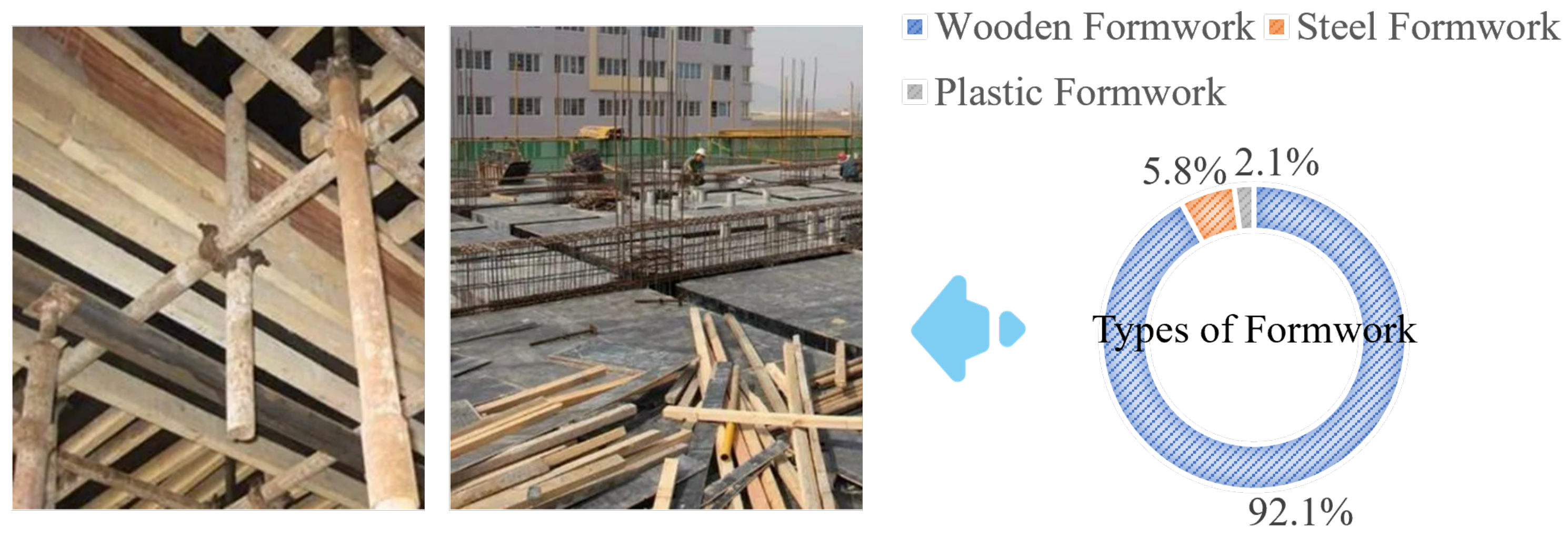
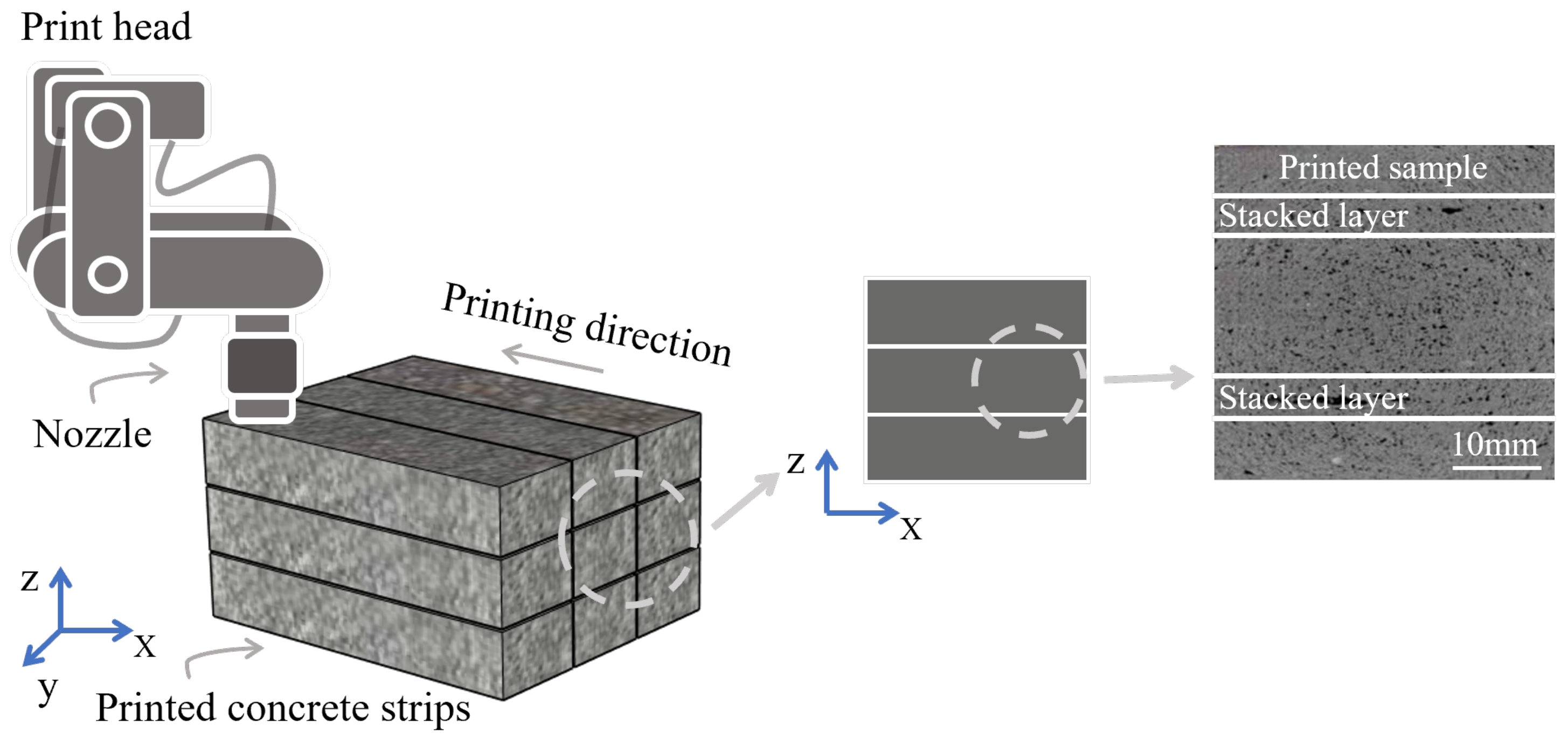
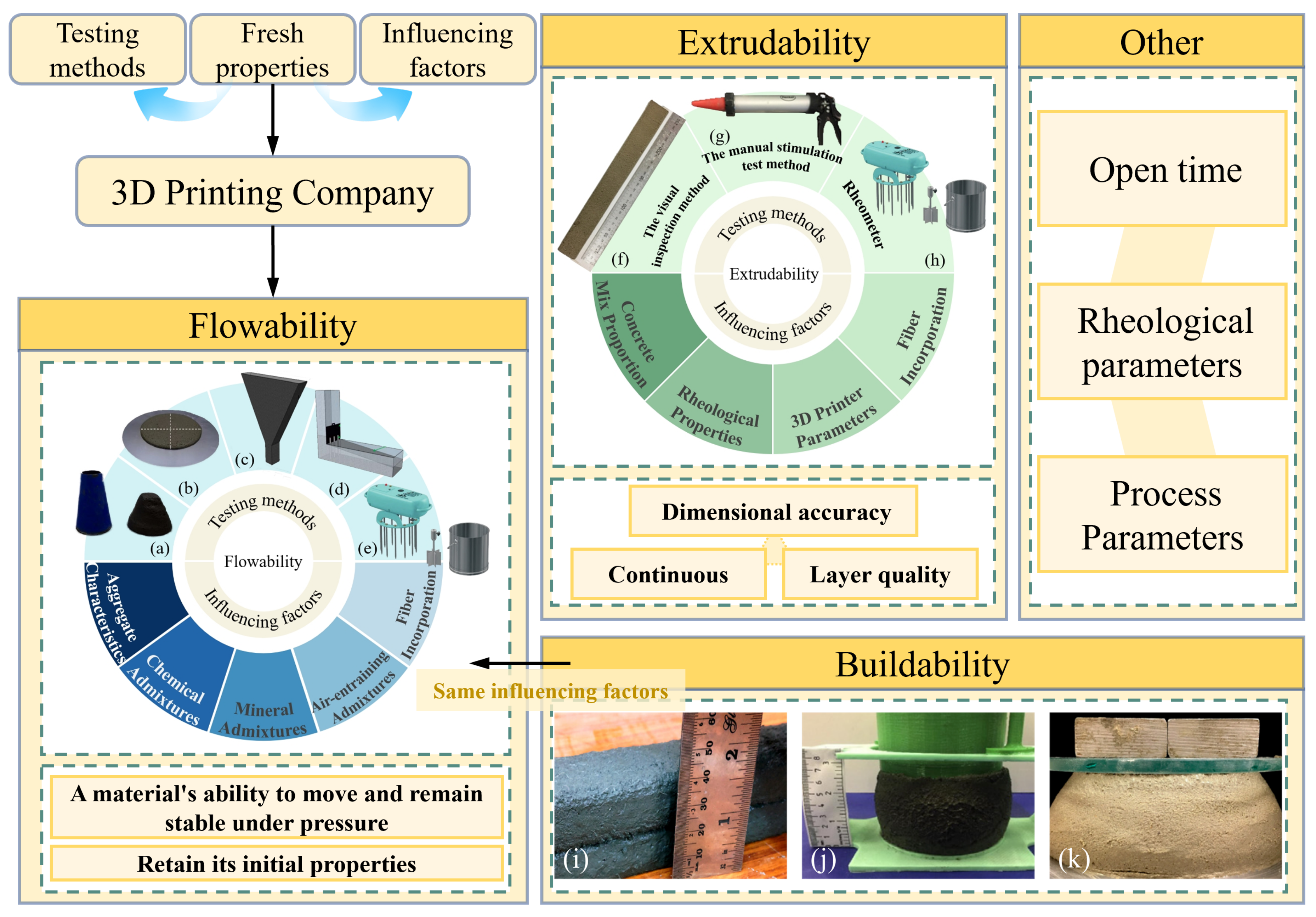
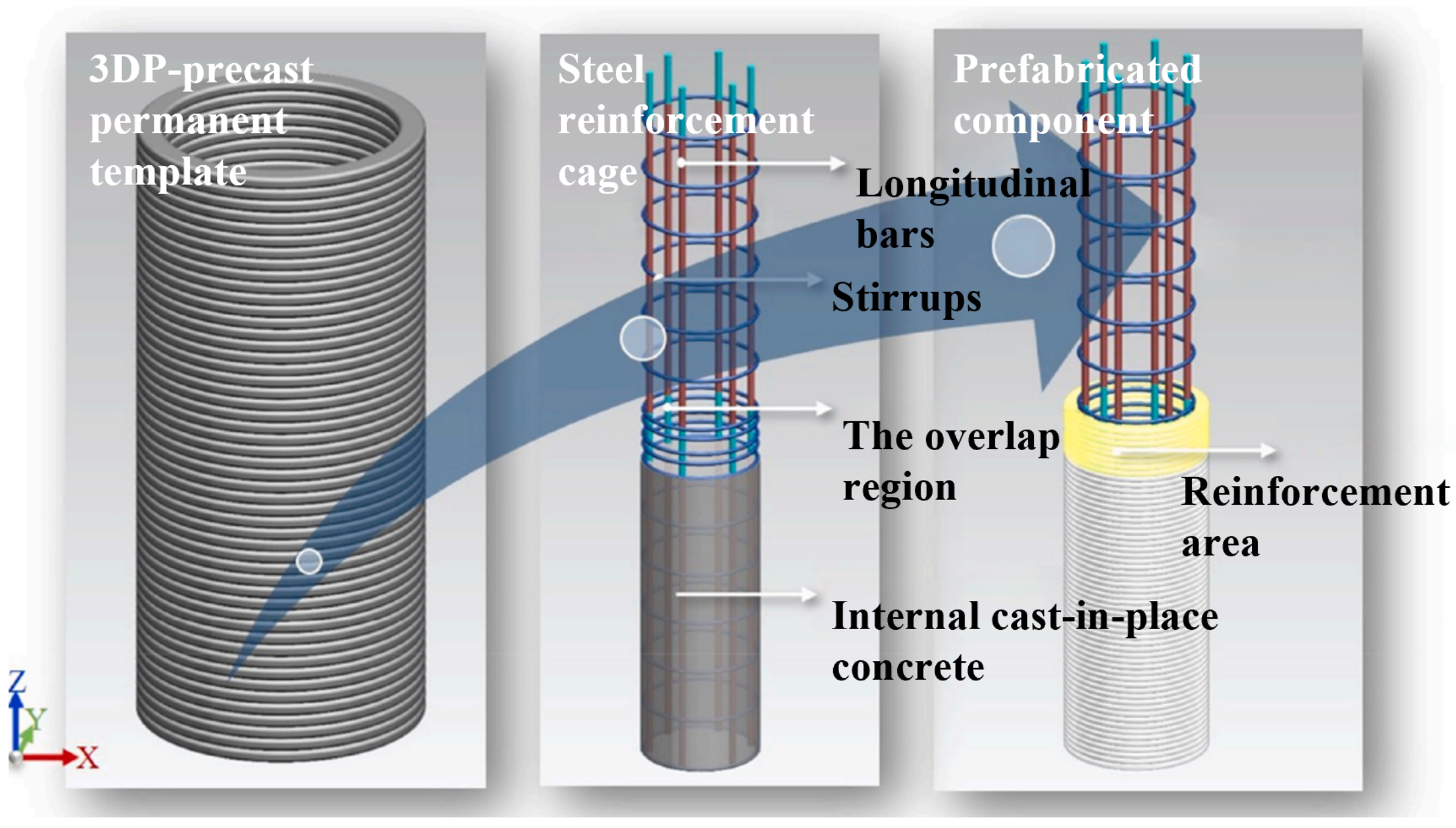



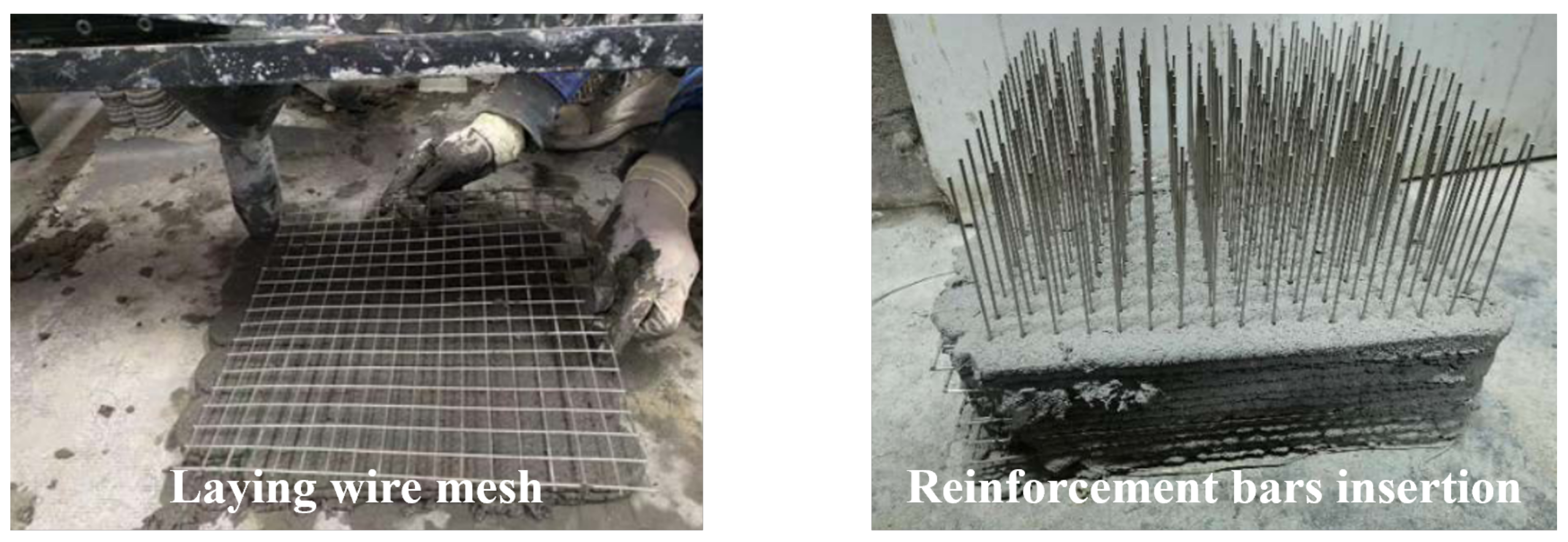

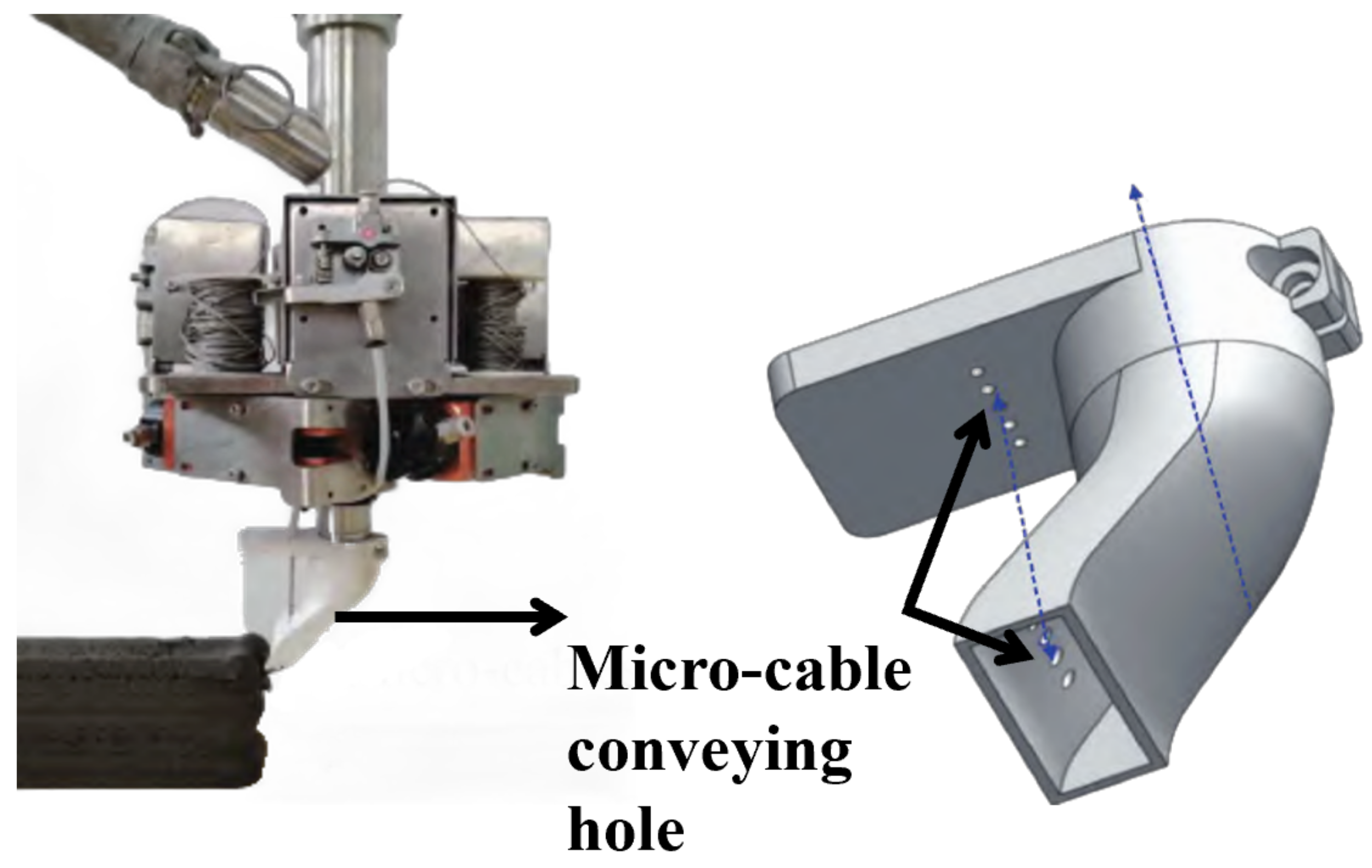
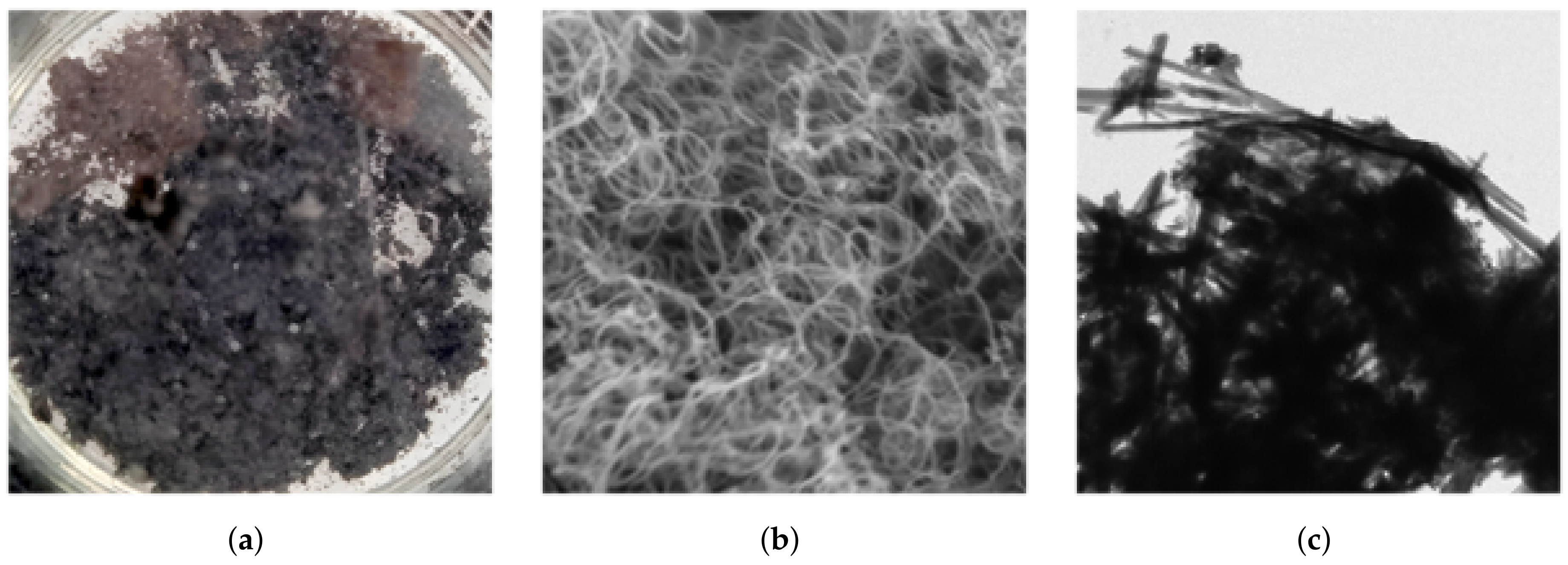

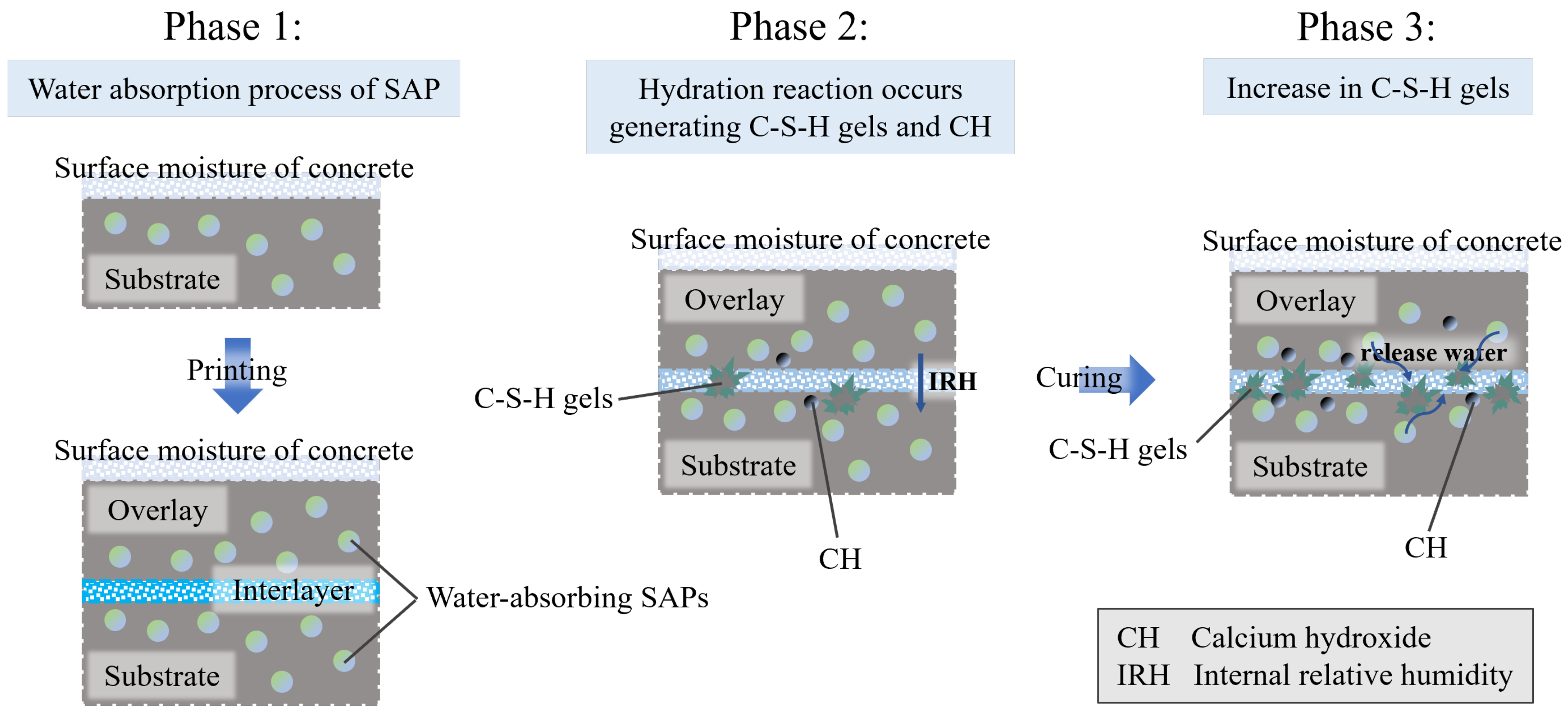
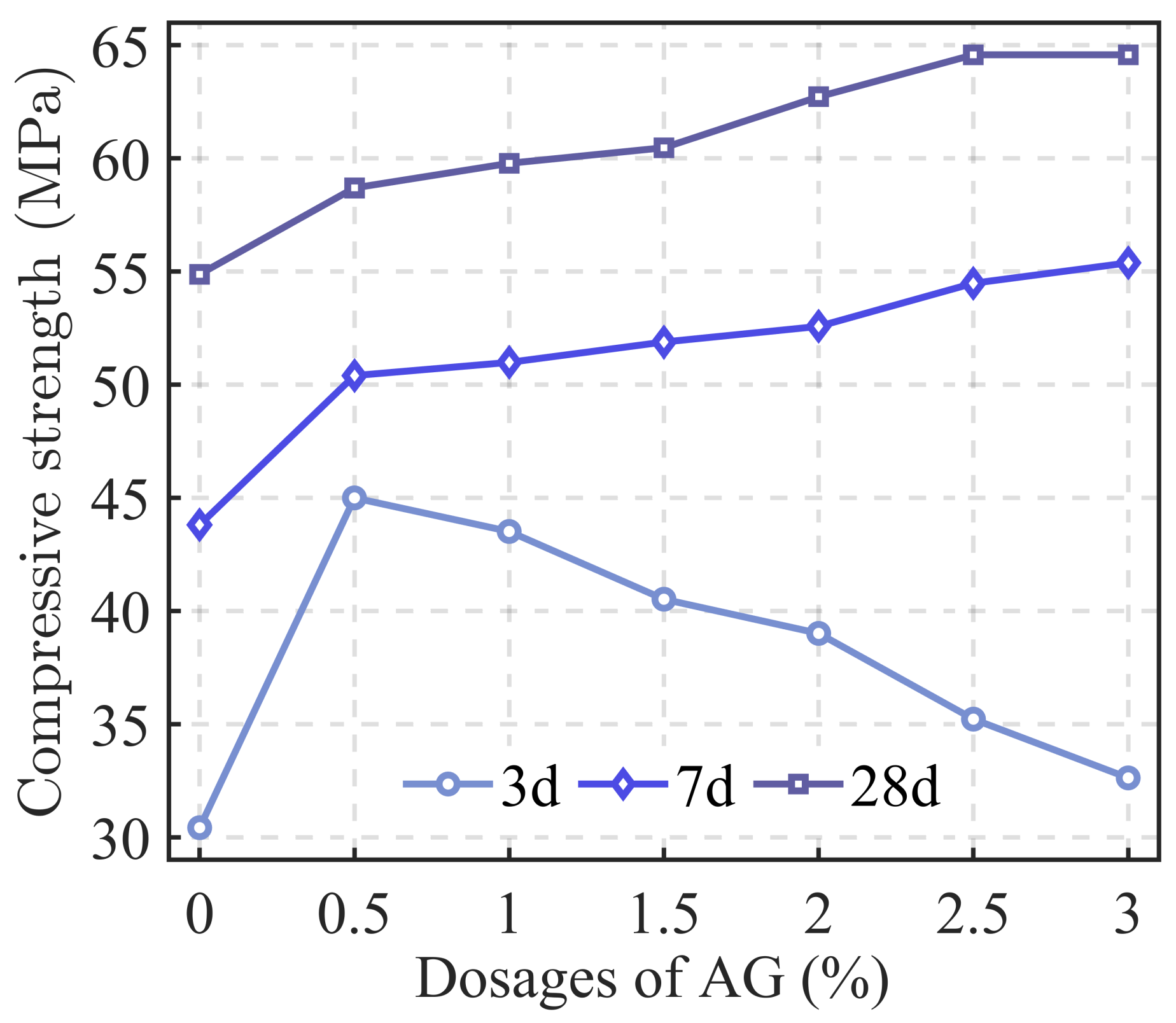
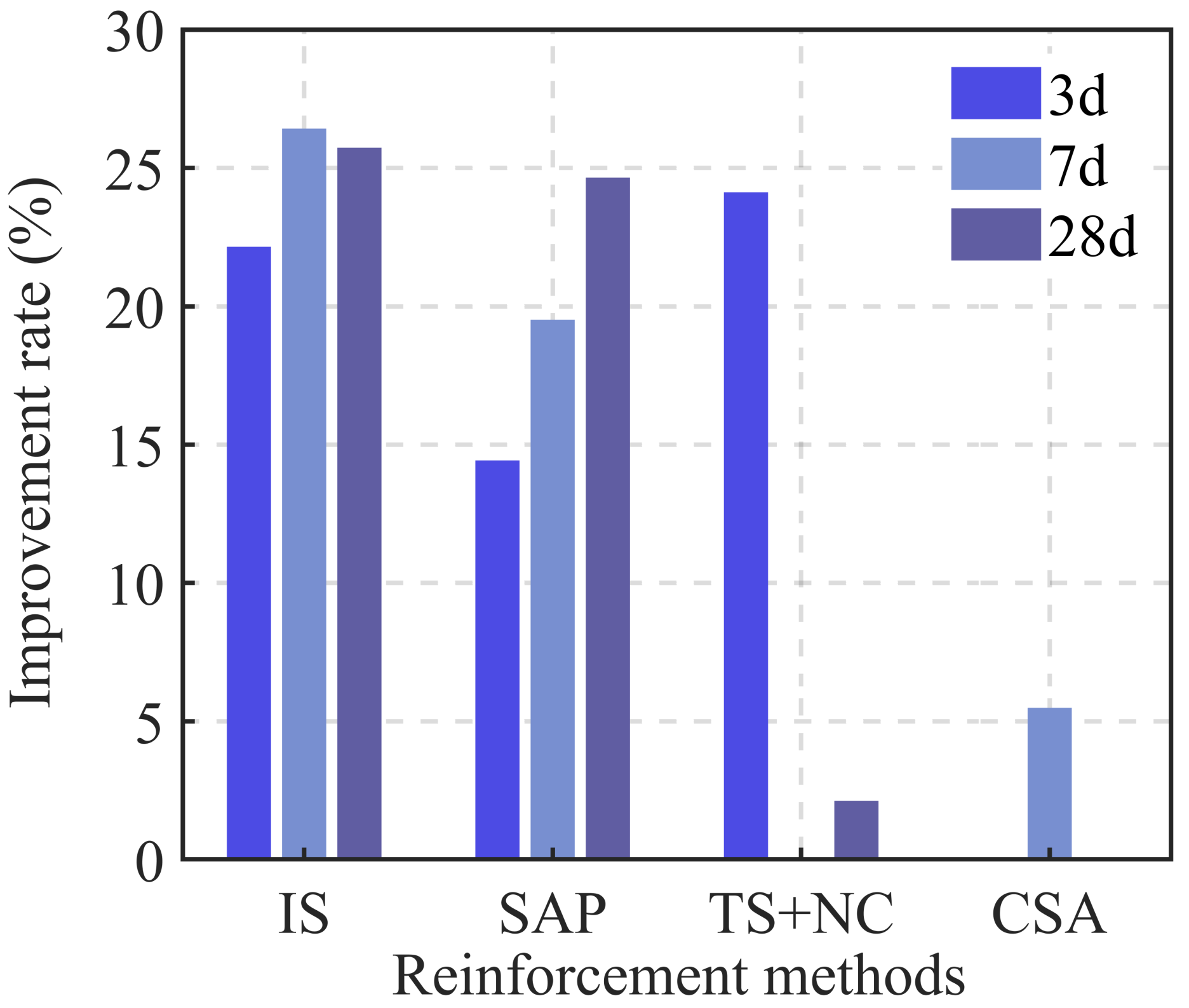

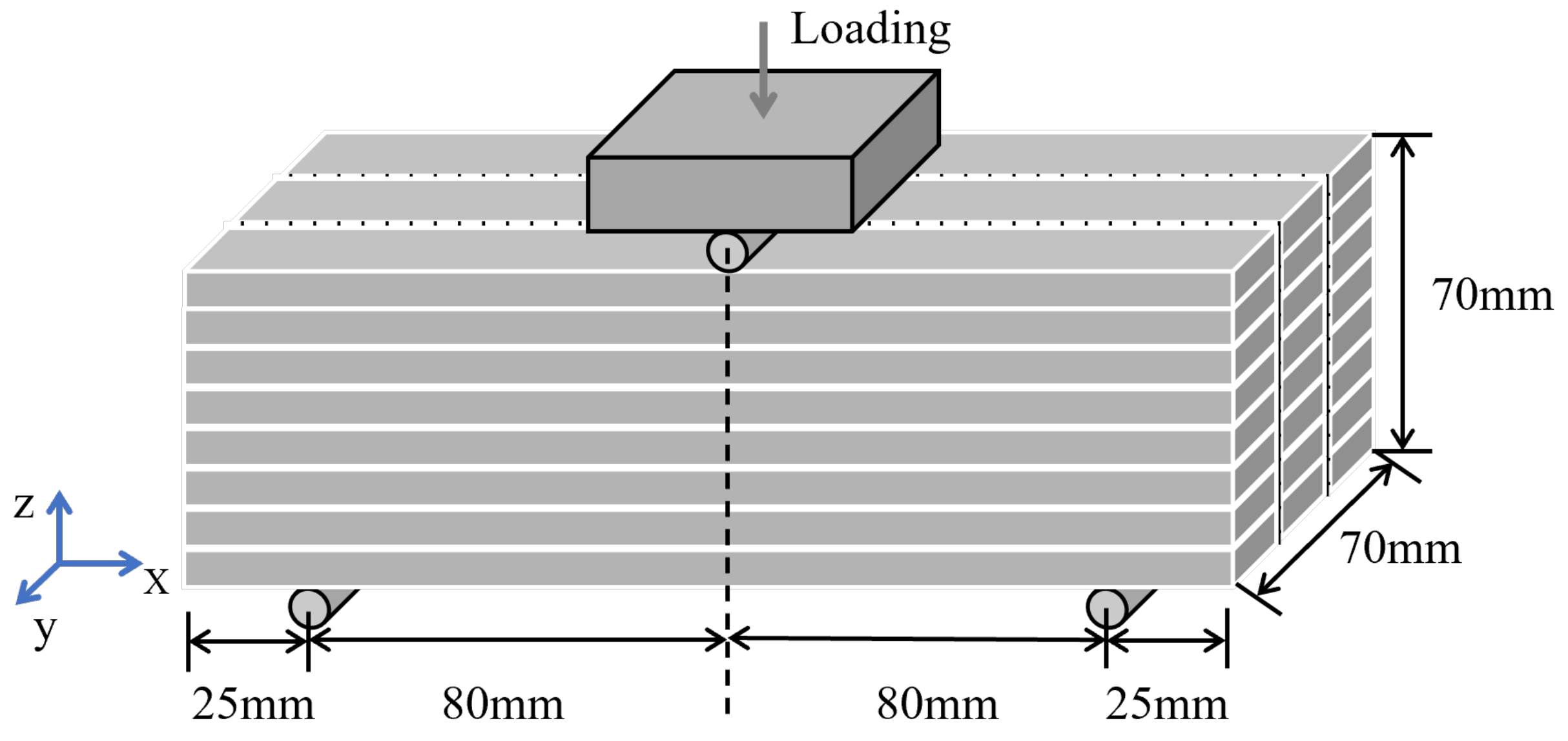
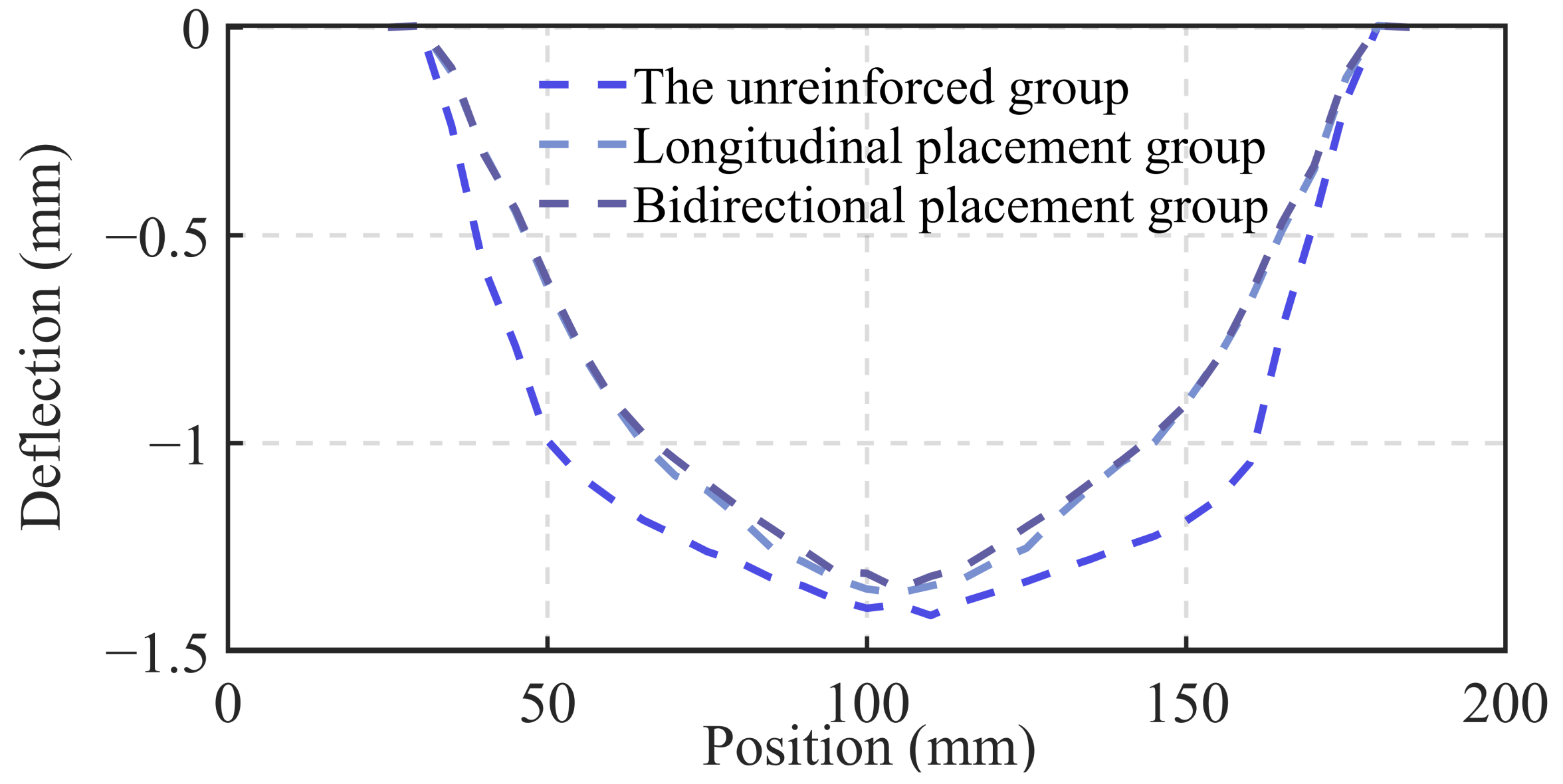
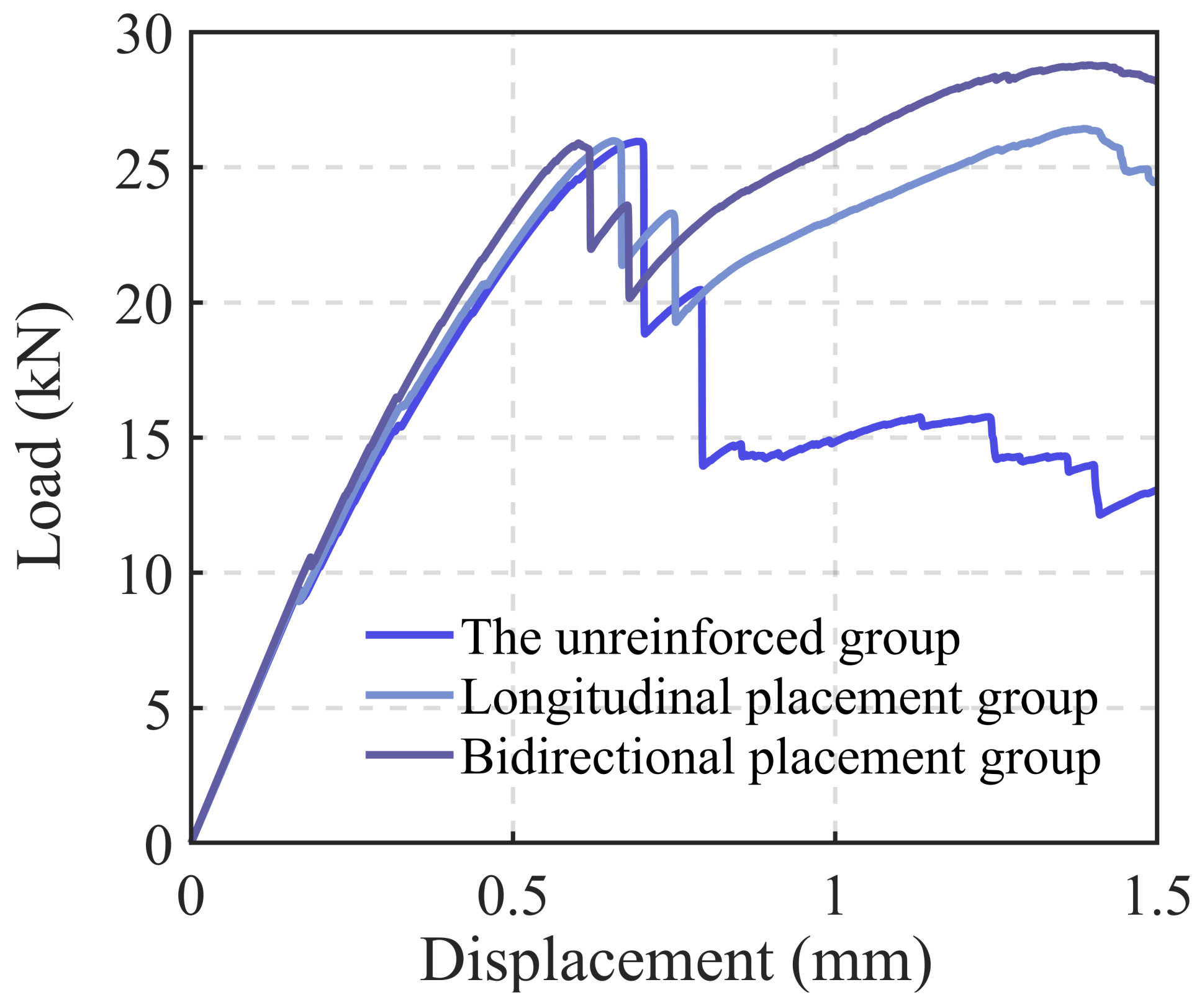
| Author | Materials | Improvement Rate (%) 1 | Optimal Dosage (%) | ||
|---|---|---|---|---|---|
| Compressive Strength 2 | Tensile Strength 2 | Flexural Strength 2 | |||
| B. Li [81] | PVAF | −0.81 | / | 6.72 | 0.25 |
| C. Zhang [82] | PVAF | −5.31 | / | 2.7 | 0.1 |
| PPF | 23.30 | / | 2.7 | ||
| SSF | −3.24 | / | 30.63 | ||
| B. Panda [83] | GF | −12.80 | 78.36 | 43.41 | 1 |
| M. Hambach [84] | CF | −25.28 | / | 174.53 | 1 |
| Y. Zhao and X. Wu [85,86] | BF | 26.04 (7 d) | / | 18.29 (7 d) | 0.3 |
| 28.22 (28 d) | 25.4 (28 d) | ||||
| J. Xia [87] | SF | 65.17 | 131.25 | / | 2 |
| J. Hu [88] | SF | 39.21 | 149.25 | 75.63 | 2.4 |
| Author | Reinforcement Methods | Compressive Strength 2Z | Interlayer Adhesion 2Y | ||
|---|---|---|---|---|---|
| Curing Age | Improvement Rate (%) 1 | Curing Age | Improvement Rate (%) 1 | ||
| B. Zareiyan [106] | Interlocking structure | 3 d | 17.37 | 3 d | 22.15 |
| 7 d | 19.62 | 7 d | 26.42 | ||
| 28 d | 13.09 | 28 d | 25.73 | ||
| G. Moelich [107] | SAP | / | 56 d | 10.00 | |
| Q. Luo [108] | SAP | 15 min | 282.17 | 3 d | 14.34 |
| 30 min | 174.61 | 7 d | 19.51 | ||
| 60 min | 92.75 | 28 d | 24.65 | ||
| T. Pan [109] | TS + Nc | / | 3 d | 24.12 | |
| / | 28 d | 2.13 | |||
| H. Yao [110] | AG | 3 d | 7.23 | 3 d | −58.48 |
| 7 d | 26.43 | 7 d | −54.43 | ||
| 28 d | 17.67 | 28 d | −51.14 | ||
| Y. Tao [111] | CSA | / | 7 d | 5.49 | |
| Cement | Mineral Powder | Silica Fume | Coarse Sand | Fine Sand | Water Reducer | Retarder | PVA Fiber |
|---|---|---|---|---|---|---|---|
| 1 | 0.8 | 0.2 | 0.5 | 0.1 | 0.04 | 0.03 | 1.2% |
Disclaimer/Publisher’s Note: The statements, opinions and data contained in all publications are solely those of the individual author(s) and contributor(s) and not of MDPI and/or the editor(s). MDPI and/or the editor(s) disclaim responsibility for any injury to people or property resulting from any ideas, methods, instructions or products referred to in the content. |
© 2025 by the authors. Licensee MDPI, Basel, Switzerland. This article is an open access article distributed under the terms and conditions of the Creative Commons Attribution (CC BY) license (https://creativecommons.org/licenses/by/4.0/).
Share and Cite
Nan, B.; Qiao, Y.; Leng, J.; Bai, Y. Advancing Structural Reinforcement in 3D-Printed Concrete: Current Methods, Challenges, and Innovations. Materials 2025, 18, 252. https://doi.org/10.3390/ma18020252
Nan B, Qiao Y, Leng J, Bai Y. Advancing Structural Reinforcement in 3D-Printed Concrete: Current Methods, Challenges, and Innovations. Materials. 2025; 18(2):252. https://doi.org/10.3390/ma18020252
Chicago/Turabian StyleNan, Bo, Youxin Qiao, Junjie Leng, and Yikui Bai. 2025. "Advancing Structural Reinforcement in 3D-Printed Concrete: Current Methods, Challenges, and Innovations" Materials 18, no. 2: 252. https://doi.org/10.3390/ma18020252
APA StyleNan, B., Qiao, Y., Leng, J., & Bai, Y. (2025). Advancing Structural Reinforcement in 3D-Printed Concrete: Current Methods, Challenges, and Innovations. Materials, 18(2), 252. https://doi.org/10.3390/ma18020252





